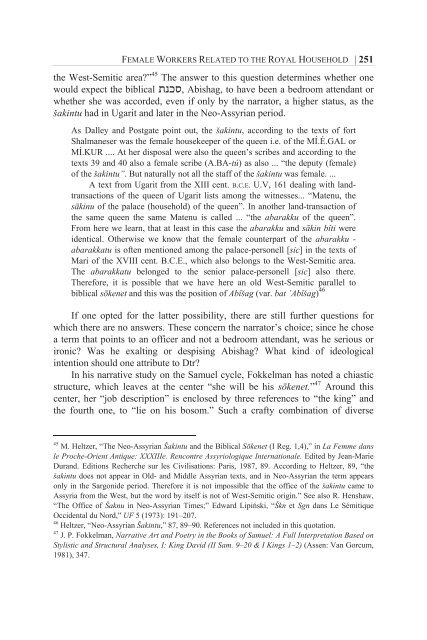Women at Work in the Deuteronomistic History - International Voices ...
Women at Work in the Deuteronomistic History - International Voices ...
Women at Work in the Deuteronomistic History - International Voices ...
You also want an ePaper? Increase the reach of your titles
YUMPU automatically turns print PDFs into web optimized ePapers that Google loves.
FEMALE WORKERS RELATED TO THE ROYAL HOUSEHOLD | 251<br />
<strong>the</strong> West-Semitic area?” 45 The answer to this question determ<strong>in</strong>es whe<strong>the</strong>r one<br />
would expect <strong>the</strong> biblical תנכס, Abishag, to have been a bedroom <strong>at</strong>tendant or<br />
whe<strong>the</strong>r she was accorded, even if only by <strong>the</strong> narr<strong>at</strong>or, a higher st<strong>at</strong>us, as <strong>the</strong><br />
šak<strong>in</strong>tu had <strong>in</strong> Ugarit and l<strong>at</strong>er <strong>in</strong> <strong>the</strong> Neo-Assyrian period.<br />
As Dalley and Postg<strong>at</strong>e po<strong>in</strong>t out, <strong>the</strong> šak<strong>in</strong>tu, accord<strong>in</strong>g to <strong>the</strong> texts of fort<br />
Shalmaneser was <strong>the</strong> female housekeeper of <strong>the</strong> queen i.e. of <strong>the</strong> MÍ.É.GAL or<br />
MÍ.KUR .... At her disposal were also <strong>the</strong> queen’s scribes and accord<strong>in</strong>g to <strong>the</strong><br />
texts 39 and 40 also a female scribe (A.BA-tú) as also ... “<strong>the</strong> deputy (female)<br />
of <strong>the</strong> šak<strong>in</strong>tu”. But n<strong>at</strong>urally not all <strong>the</strong> staff of <strong>the</strong> šak<strong>in</strong>tu was female. ...<br />
A text from Ugarit from <strong>the</strong> XIII cent. B.C.E. U.V, 161 deal<strong>in</strong>g with landtransactions<br />
of <strong>the</strong> queen of Ugarit lists among <strong>the</strong> witnesses... “M<strong>at</strong>enu, <strong>the</strong><br />
sāk<strong>in</strong>u of <strong>the</strong> palace (household) of <strong>the</strong> queen”. In ano<strong>the</strong>r land-transaction of<br />
<strong>the</strong> same queen <strong>the</strong> same M<strong>at</strong>enu is called ... “<strong>the</strong> abarakku of <strong>the</strong> queen”.<br />
From here we learn, th<strong>at</strong> <strong>at</strong> least <strong>in</strong> this case <strong>the</strong> abarakku and sāk<strong>in</strong> bîti were<br />
identical. O<strong>the</strong>rwise we know th<strong>at</strong> <strong>the</strong> female counterpart of <strong>the</strong> abarakku -<br />
abarakk<strong>at</strong>u is often mentioned among <strong>the</strong> palace-personell [sic] <strong>in</strong> <strong>the</strong> texts of<br />
Mari of <strong>the</strong> XVIII cent. B.C.E., which also belongs to <strong>the</strong> West-Semitic area.<br />
The abarakk<strong>at</strong>u belonged to <strong>the</strong> senior palace-personell [sic] also <strong>the</strong>re.<br />
Therefore, it is possible th<strong>at</strong> we have here an old West-Semitic parallel to<br />
biblical sōkenet and this was <strong>the</strong> position of Abîšag (var. b<strong>at</strong> ’Abîšag) 46<br />
If one opted for <strong>the</strong> l<strong>at</strong>ter possibility, <strong>the</strong>re are still fur<strong>the</strong>r questions for<br />
which <strong>the</strong>re are no answers. These concern <strong>the</strong> narr<strong>at</strong>or’s choice; s<strong>in</strong>ce he chose<br />
a term th<strong>at</strong> po<strong>in</strong>ts to an officer and not a bedroom <strong>at</strong>tendant, was he serious or<br />
ironic? Was he exalt<strong>in</strong>g or despis<strong>in</strong>g Abishag? Wh<strong>at</strong> k<strong>in</strong>d of ideological<br />
<strong>in</strong>tention should one <strong>at</strong>tribute to Dtr?<br />
In his narr<strong>at</strong>ive study on <strong>the</strong> Samuel cycle, Fokkelman has noted a chiastic<br />
structure, which leaves <strong>at</strong> <strong>the</strong> center “she will be his sōkenet.” 47 Around this<br />
center, her “job description” is enclosed by three references to “<strong>the</strong> k<strong>in</strong>g” and<br />
<strong>the</strong> fourth one, to “lie on his bosom.” Such a crafty comb<strong>in</strong><strong>at</strong>ion of diverse<br />
45 M. Heltzer, “The Neo-Assyrian Šak<strong>in</strong>tu and <strong>the</strong> Biblical Sōkenet (I Reg. 1,4),” <strong>in</strong> La Femme dans<br />
le Proche-Orient Antique: XXXIIIe. Rencontre Assyriologique Intern<strong>at</strong>ionale. Edited by Jean-Marie<br />
Durand. Editions Recherche sur les Civilis<strong>at</strong>ions: Paris, 1987, 89. Accord<strong>in</strong>g to Heltzer, 89, “<strong>the</strong><br />
šak<strong>in</strong>tu does not appear <strong>in</strong> Old- and Middle Assyrian texts, and <strong>in</strong> Neo-Assyrian <strong>the</strong> term appears<br />
only <strong>in</strong> <strong>the</strong> Sargonide period. Therefore it is not impossible th<strong>at</strong> <strong>the</strong> office of <strong>the</strong> šak<strong>in</strong>tu came to<br />
Assyria from <strong>the</strong> West, but <strong>the</strong> word by itself is not of West-Semitic orig<strong>in</strong>.” See also R. Henshaw,<br />
“The Office of Šaknu <strong>in</strong> Neo-Assyrian Times;” Edward Lipiński, “Škn et Sgn dans Le Sémitique<br />
Occidental du Nord,” UF 5 (1973): 191–207.<br />
46 Heltzer, “Neo-Assyrian Šak<strong>in</strong>tu,” 87, 89–90. References not <strong>in</strong>cluded <strong>in</strong> this quot<strong>at</strong>ion.<br />
47 J. P. Fokkelman, Narr<strong>at</strong>ive Art and Poetry <strong>in</strong> <strong>the</strong> Books of Samuel: A Full Interpret<strong>at</strong>ion Based on<br />
Stylistic and Structural Analyses, I: K<strong>in</strong>g David (II Sam. 9–20 & I K<strong>in</strong>gs 1–2) (Assen: Van Gorcum,<br />
1981), 347.




